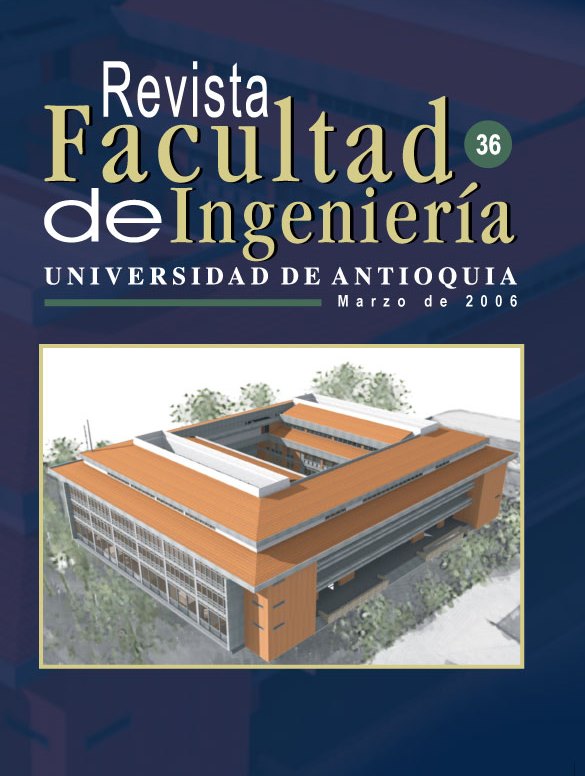Modelo matemático para los fenómenos de combustión en un horno de cubilote
DOI:
https://doi.org/10.17533/udea.redin.343246Palabras clave:
horno de cubilote, modelo matemático, combustiónResumen
A mathematical model of the combustion phenomena occurring in a cupola furnace is presented. The most important heterogeneous coke-gas reactions: combustion, CO2 gasification and steam gasification were used for modelling and Matlab (version 5.3) was used to solve said model. Results were compared with experimental data obtained in the cupola furnace of the ecoefficient plant at the University of Antioquia. The model evaluates composition profiles along the furnace column, composition of gases at the chimney and velocity at which metal is fed during this operation. Maximum deviations within 1% for CO2, 5% for CO, 7% for combustion ratio, and 9% for velocity of metal charge were obtained with the model.
Descargas
Citas
C. Silva. Modelo matemático para la disolución del silicio en el horno de cubilote. Informe final tesis de pregrado para optar al título de ingeniera metalúrgica. Medellín. Facultad de Ingeniería. Universidad de Antioquia. 2004. p. 18.
]American Foundry Society. AFS Cupola Handbook. Estados Unidos. AFS. 6.a ed. 1999. pp. 12-6, 12-7.
J. Declery. “Chemical Reactions in Cupola Practice”. En: The Foundry. Vol. 32. USA. Aug. 1908. pp. 296-298.
A. W. Belden. “Foundry Cupola Gases and Temperatures”. En: U. S. Bureau of Mines. Bulletin 54. USA. 1913.
J. G. Breen. “Calculation of Metal, Coke and Gas Temperature Distributions in a Cupola Furnace”. En: Proceedings Australasian Institute of Mining and Metallurgy. N.o 208. Australia. December, 1963. pp. 25-42.
J. Grennan. “Visual Observation of Melting in a Cupola”. En: AFS transaction. Vol. 31. USA. 1924. pp. 101-110.
N. Meysson. “Mathematical Simulation Model of Cupola Operation”. En: Fonderie. Francia. 1975. p. 165.
A. B. Oraper, K. Nyamekye. “Energy Model Predictions of Gas Composition and Temperature Profiles in a Cold Blast Cupola”. En: AFS Transactions. Vol. 93. USA. 1985. pp. 615-626.
K. Nyamekye, A. B. Craper. “Heat and Mass Balances in a Cold Blast Cupola”. En: AFS Transactions. Vol. 97. USA. 1989. pp. 837-846.
K. Seymour. “The Properties of Coke Affecting the Cupola Performance”. En: AFS Transactions. Vol. 90. USA. 1982. pp. 825-833.
V. Stanek, B. Q. Li, J. Szekely. “Mathematical Model of a Cupola Furnace-Part I: Formulation and an Algorithm to Solve the Model”. En: AFS Transactions. Vol. 100. USA. 1992. pp. 425-437.
V. Stanek, S. Katz, C. Landefeld. “Mathematical Model of a Cupola Furnace—Part VII: Effect of Humidity of the Blast on the Cupola Performance”. En: AFS Transactions. Vol. 100. USA. 1992. pp. 839-845.
H. D. Mejía, R. Aristizábal, C. Silva. Estudio del comportamiento del silicio adicionado como carburo de silicio en el horno de cubilote. Proyecto CODI de investigación aplicada. Facultad de Ingeniería. Universidad de Antioquia. Medellín. 2002.
Software AFS Cupola Model. AFS. USA. 1999.
Descargas
Publicado
Cómo citar
Número
Sección
Licencia
Los artículos disponibles en la Revista Facultad de Ingeniería, Universidad de Antioquia están bajo la licencia Creative Commons Attribution BY-NC-SA 4.0.
Eres libre de:
Compartir — copiar y redistribuir el material en cualquier medio o formato
Adaptar : remezclar, transformar y construir sobre el material.
Bajo los siguientes términos:
Reconocimiento : debe otorgar el crédito correspondiente , proporcionar un enlace a la licencia e indicar si se realizaron cambios . Puede hacerlo de cualquier manera razonable, pero no de ninguna manera que sugiera que el licenciante lo respalda a usted o su uso.
No comercial : no puede utilizar el material con fines comerciales .
Compartir igual : si remezcla, transforma o construye a partir del material, debe distribuir sus contribuciones bajo la misma licencia que el original.
El material publicado por la revista puede ser distribuido, copiado y exhibido por terceros si se dan los respectivos créditos a la revista, sin ningún costo. No se puede obtener ningún beneficio comercial y las obras derivadas tienen que estar bajo los mismos términos de licencia que el trabajo original.










 Twitter
Twitter